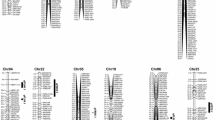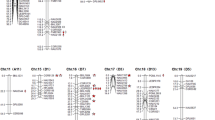Abstract
Cotton fiber fineness and maturity measured indirectly as micronaire (MIC) are important properties of determining fiber grades in the textile market. To understand the genetic control and molecular mechanisms of fiber fineness and maturity, we studied two near isogenic lines, Gossypium hirsutum, Texas Marker-1 wild type (TM-1) and immature fiber (im) mutant showing a significant difference in MIC values. The fibers from im mutant plants were finer and less mature with lower MIC values than those from the recurrent parent, TM-1. A comprehensive fiber property analysis of TM-1 and im mutant showed that the lower MIC of fibers in im mutant was due to the lower degree of fiber cell wall thickening as compared to the TM-1 fibers. Using an F2 population comprising 366 progenies derived from a cross between TM-1 and im mutant, we confirmed that the immature fiber phenotype present in a mutant plant was controlled by one single recessive gene im. Furthermore, we identified 13 simple sequence repeat markers that were closely linked to the im gene located on chromosome 3. Molecular markers associated with the im gene will lay the foundation to further investigate genetic information required for improving cotton fiber fineness and maturity.





Similar content being viewed by others
References
Boylston EK, Thibodeaux DP, Evans JP (1993) Applying microscopy to the development of a reference method for cotton fiber maturity. Textile Res J 63:80–87
Bradow JM, Davidonis GH (2000) Quantitation of fiber quality and the cotton production–processing interface: a physiologist’s perspective. J Cotton Sci 4:34–64
Ethridge D (2010) Changes in global cotton markets: causes and effects. http://thinktechlibttuedu/ttu-ir/bitstream/handle/2346/1731/Changes%20in%20Global%20Cottonpdf?sequence=. Accessed 24 July 2012
Fang DD, Xiao J, Canci PC, Cantrell RG (2010) A new SNP haplotype associated with blue disease resistance gene in cotton (Gossypium hirsutum L.). Theor Appl Genet 120:943–953
Guo W, Cai C, Wang C, Zhao L, Wang L, Zhang T (2008) A preliminary analysis of genome structure and composition in Gossypium hirsutum. BMC Genomics 9:314
Kohel RJ, McMichael SC (1990) Immature fiber mutant of upland cotton. Crop Sci 30:419–421
Kohel RJ, Richmond TR, Lewis CF (1970) Texas Marker-1: description of a genetic standard for Gossypium hirsutum. Crop Sci 10:670–671
Kohel RJ, Quisenberry JE, Benedict CR (1974) Fiber elongation and dry weight changes in mutant lines of cotton. Crop Sci 14:471–474
Kohel RJ, Stelly DM, Yu JZ (2002) Tests of six cotton (Gossypium hirsutum L.) mutants for association with aneuploids. J Hered 93:130–132
Lacape JM, Jacobs J, Arioli T, Derijcker R, Forestier-Chiron N, Llewellyn D, Jean J, Thomas E, Viot C (2009) A new interspecific, Gossypium hirsutum × G. barbadense, RIL population: towards a unified consensus linkage map of tetraploid cotton. Theor Appl Genet 119:281–292
Michelmore RW, Paran I, Kesseli RV (1991) Identification of markers linked to disease-resistance genes by bulked segregant analysis: a rapid method to detect markers in specific genomic regions by using segregating populations. Proc Natl Acad Sci USA 88:9828–9832
Rong J, Abbey C, Bowers JE, Brubaker CL, Chang C, Chee PW, Delmonte TA, Ding X, Garza JJ, Marler BS, Park CH, Pierce GJ, Rainey KM, Rastogi VK, Schulze SR, Trolinder NL, Wendel JF, Wilkins TA, Williams-Coplin TD, Wing RA, Wright RJ, Zhao X, Zhu L, Paterson AH (2004) A 3347-locus genetic recombination map of sequence-tagged sites reveals features of genome organization, transmission and evolution of cotton (Gossypium). Genetics 166:389–417
Thibodeaux DP, Rajasekaran K (1999) Development of new reference standards for cotton fiber maturity. J Cotton Sci 3:188–193
Van Ooijen JW, Voorrips RE (2001a) JoinMap® 3.0 software for the calculation of genetic linkage maps. Plant Research International, Wageningen
Van Ooijen JW, Voorrips RE (2001b) MapQTL® 4.0 software for the calculation of genetic linkage maps. Plant Research International, Wageningen
Xiao J, Wu K, Fang DD, Stelly DM, Yu JZ, Cantrell RG, Yu J (2009) New SSR markers for use in cotton (Gossypium spp.) improvement. J Cotton Sci 13:75–157
Yu J, Yu S, Lu C, Wang W, Fan S, Song M, Lin Z, Zhang X, Zhang J (2007) High-density linkage map of cultivated allotetraploid cotton based on SSR, TRAP, SRAP and AFLP markers. J Integr Plant Biol 49:716–724
Yu Y, Yuan D, Liang S, Li X, Wang X, Lin Z, Zhang X (2011) Genome structure of cotton revealed by a genome-wide SSR genetic map constructed from a BC1 population between Gossypium hirsutum and G. barbadense. BMC Genomics 12:15
Yu JZ, Kohel RJ, Fang DD, Cho J, Van Deynze A, Ulloa M, Hoffman SM, Pepper AE, Stelly DM, Jenkins JN, Saha S, Kumpatla SP, Shah MR, Hugie WV, Percy RG (2012) A high-density simple sequence repeat and single nucleotide polymorphism genetic map of the tetraploid cotton genome. G3 2:43–58
Acknowledgments
This work was supported by the USDA-ARS, and Cotton Incorporated. We thank Dr. Russell J. Kohel of USDA-ARS-SPARC for providing cottonseeds of TM-1 and im mutant and Dr. Barbara Triplett of USDA-ARS-SRRC for growing cotton in 2007 and 2008. The authors acknowledge Ms. Holly King and Jeannine Moraitis for fiber measurements and image analyses, Ms. Ping Li for assistances of mapping, Ms. Olga Richard, Shannon Combe, and LaTonya Holmes Suber for assistances of collecting fiber samples. We also thank Mrs Sheron Simpson and Dr. Brian Scheffler at Genomic and Bioinformatic Research Unit at Stoneville, MS for their excellent support in SSR marker analysis. Mention of trade names or commercial products in this publication is solely for the purpose of providing specific information and does not imply recommendation or endorsement by the USDA that is an equal opportunity employer.
Author information
Authors and Affiliations
Corresponding author
Additional information
Communicated by B. Friebe.
Rights and permissions
About this article
Cite this article
Kim, H.J., Moon, H.S., Delhom, C.D. et al. Molecular markers associated with the immature fiber (im) gene affecting the degree of fiber cell wall thickening in cotton (Gossypium hirsutum L.). Theor Appl Genet 126, 23–31 (2013). https://doi.org/10.1007/s00122-012-1956-x
Received:
Accepted:
Published:
Issue Date:
DOI: https://doi.org/10.1007/s00122-012-1956-x




